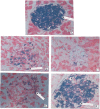Protective effect of quercetin on the morphology of pancreatic beta-cells of streptozotocin-treated diabetic rats
- PMID: 20162074
- PMCID: PMC2816429
- DOI: 10.4314/ajtcam.v4i1.31196
Protective effect of quercetin on the morphology of pancreatic beta-cells of streptozotocin-treated diabetic rats
Abstract
This study was undertaken to investigate the protective effects of quercetin (QCT) on the morphology of pancreatic beta-cells against diabetes mellitus and oxidative stress experimentally-induced by streptozotocin (STZ) treatment in Wistar rats. Fifty male and female Wistar rats (200-250 g) were randomly divided into three experimental groups (i. e., control, STZ-treated, and STZ + Quercetin-treated groups). Diabetes was induced in the diabetic groups (B and C) of animals, by a single intraperitoneal injection of STZ (75 mg/kg), while each of the rats in the 'control' group received equal volume of citrate buffer (pH 6.3) solution intraperitoneally. In group C rats, quercetin (QCT, 25 mg/kg/day i.p.) was injected daily for 3 days prior to STZ treatment, and QCT administration continued until the end of the study period (30 days). Diabetes mellitus was confirmed by using Bayer's Glucometer Elite and compatible blood glucose test strips. The rats were sacrificed serially until the end of the study period (after 30 days). The pancreases of the sacrificed rats were excised and randomly processed for histological staining and biochemical assays for antioxidant enzymes [such as glutathione peroxidase (GSHPx), superoxide dismutase (SOD), catalase (CAT), malondialdehyde (MDA) and serum nitric oxide (NO)]. In the diabetic state, pancreatic beta-cells of STZ-treated group B rats histologically demonstrated an early chromatin aggregation, cytoplasmic vesiculation in the central beta-cells, nuclear shrinkage, and lysis of beta-cells with distortion of granules. The morphology of QCT-treated rats' pancreases showed viable cellularity with distinct beta-cell mass. STZ treatment significantly decreased (p<0.05) GSHPx, SOD, CAT and pancreatic insulin content. However, STZ treatment increased blood glucose concentrations, MDA and serum NO. The QCT-treated group of animals showed a significant decrease (p<0.05) in elevated blood glucose, MDA and NO. Furthermore, QCT treatment significantly increased (p<0.05) antioxidant enzymes' activities, as well as pancreatic insulin contents. Quercetin (QCT) treatment protected and preserved pancreatic beta-cell architecture and integrity. In conclusion, the findings of the present experimental animal study indicate that QCT treatment has beneficial effects on pancreatic tissues subjected to STZ-induced oxidative stress by directly quenching lipid peroxides and indirectly enhancing production of endogenous antioxidants.
Keywords: Antioxidant enzymes; Pancreatic β-cell; Quercetin; Streptozotocin.
Figures


Similar articles
-
Quercetin, a flavonoid antioxidant, prevents and protects streptozotocin-induced oxidative stress and beta-cell damage in rat pancreas.Pharmacol Res. 2005 Feb;51(2):117-23. doi: 10.1016/j.phrs.2004.06.002. Pharmacol Res. 2005. PMID: 15629256
-
Exercise training prevents and protects streptozotocin-induced oxidative stress and beta-cell damage in rat pancreas.Tohoku J Exp Med. 2004 Jul;203(3):145-54. doi: 10.1620/tjem.203.145. Tohoku J Exp Med. 2004. PMID: 15240923
-
Insulin-induced immunohistochemical and morphological changes in pancreatic beta-cells of streptozotocin-treated diabetic rats.Methods Find Exp Clin Pharmacol. 2007 Sep;29(7):447-55. doi: 10.1358/mf.2007.29.7.1119168. Methods Find Exp Clin Pharmacol. 2007. PMID: 17982509
-
Effects of Nigella sativa on oxidative stress and beta-cell damage in streptozotocin-induced diabetic rats.Anat Rec A Discov Mol Cell Evol Biol. 2004 Jul;279(1):685-91. doi: 10.1002/ar.a.20056. Anat Rec A Discov Mol Cell Evol Biol. 2004. PMID: 15224410
-
Streptozotocin-induced type 1 diabetes in rodents as a model for studying mitochondrial mechanisms of diabetic β cell glucotoxicity.Diabetes Metab Syndr Obes. 2015 Apr 2;8:181-8. doi: 10.2147/DMSO.S82272. eCollection 2015. Diabetes Metab Syndr Obes. 2015. PMID: 25897251 Free PMC article. Review.
Cited by
-
Study of the Antidiabetic Activity of Punica granatum L. Fruits Aqueous Extract on the Alloxan-Diabetic Wistar Rats.Iran J Pharm Res. 2019 Winter;18(1):358-368. Iran J Pharm Res. 2019. PMID: 31089370 Free PMC article.
-
Effects of conditioned media derived from human Wharton's jelly mesenchymal stem cells on diabetic nephropathy and hepatopathy via modulating TGF-β and apelin signaling pathways in male rats.BMC Endocr Disord. 2024 Jan 5;24(1):6. doi: 10.1186/s12902-023-01535-8. BMC Endocr Disord. 2024. PMID: 38178017 Free PMC article.
-
Botanical Interventions to Improve Glucose Control and Options for Diabetes Therapy.SN Compr Clin Med. 2021 Dec;3(12):2465-2491. doi: 10.1007/s42399-021-01034-8. Epub 2021 Aug 15. SN Compr Clin Med. 2021. PMID: 35098034 Free PMC article.
-
Thymoquinone Preserves Pancreatic Islets Structure Through Upregulation of Pancreatic β-Catenin in Hypothyroid Rats.Diabetes Metab Syndr Obes. 2021 Jun 29;14:2913-2924. doi: 10.2147/DMSO.S317417. eCollection 2021. Diabetes Metab Syndr Obes. 2021. PMID: 34234489 Free PMC article.
-
Anti-hypoglycemic and hepatocyte-protective effects of hyperoside from Zanthoxylum bungeanum leaves in mice with high-carbohydrate/high-fat diet and alloxan-induced diabetes.Int J Mol Med. 2018 Jan;41(1):77-86. doi: 10.3892/ijmm.2017.3211. Epub 2017 Oct 25. Int J Mol Med. 2018. PMID: 29115390 Free PMC article.
References
-
- Bach J F. Insulin-dependent diabetes mellitus as an autoimmune disease. Endicr Rev. 1994;15:516–542. - PubMed
-
- Baynes J W. Role of oxidative stress in the development of complications in diabetes. Diabetes. 1991;40:405–412. - PubMed
-
- Bernard-Kargar C, Ktorza A. Endocrine pancreas plasticity under physiological and pathological conditions. Diabetes. 2001;50:30S–35S. - PubMed
-
- Bronner C, Landry Y. Kinetics of inhibitory effect of flavonoids on histamine secretion from mast cells. Agents Action. 1985;16:147–151. - PubMed
-
- Butler E A, Janson J, Bonner-Weir S, Ritzel R, Rizza R A, Butler P C. Beta-cell deficit and increased β-cell apoptosis in humans with type2 diabetes. Diabates. 2003;52:102–110. - PubMed
LinkOut - more resources
Full Text Sources
Miscellaneous
